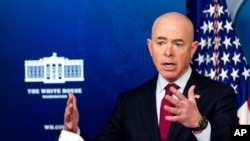U.S. homeland security officials warn the chances for increased violence or terror attacks are likely to grow over the next six months, citing a volatile convergence of pervasive disinformation, conspiracy theories and several high-profile events like the anticipated Supreme Court decision on abortion and the country’s mid-term elections.
The Department of Homeland Security reissued its National Terrorism Advisory System (NTAS) Bulletin Tuesday, hours before the previous advisory was set to expire, citing a continued heightened threat environment despite the lack of any specific or credible threats.
“As recent acts of violence in communities across the country have so tragically demonstrated, the nation remains in a heightened threat environment, and we expect that environment will become more dynamic in the coming months,” Homeland Security Secretary Alejandro Mayorkas said in a statement.
“The Department of Homeland Security remains steadfast in our commitment to provide timely information and resources to the American public and our partners across every level of government,” Mayorkas added, promising “regular engagements” to promote the sharing of intelligence, training and other resources.
According to the new advisory, potential targets in the United States include public gatherings, faith-based institutions, schools, racial and religious minorities, government facilities and personnel, critical infrastructure, the media, and perceived ideological opponents.
This is the sixth time that DHS has issued a NTAS bulletin since January 2021 and comes as the U.S. is reeling from a spate of deadly mass shootings, including last month’s rampage by a white, teenage gunman at a grocery store in Buffalo, New York who specifically targeted Black victims.
The suspect in that case, Payton Gendron, has been charged with domestic terrorism motivated by hate and 10 counts of first-degree murder.
Less than two weeks later, 18-year-old Salvador Ramos entered the Robb Elementary School in Uvalde, Texas, shooting and killing 19 students and two teachers, before he himself was killed.
Other deadly shootings in Tulsa, Oklahoma and Laguna Woods, California have also quickly been overshadowed.
A Washington-based non-profit organization that tracks shootings, GunViolenceArchive.org, found that since June 3 alone, more than 124 people have been killed and 325 wounded in more than 300 shootings across the U.S.
U.S. homeland security officials say they have been trying to work more closely with state and local officials, and with community organizations, to help them identify individuals who may be radicalized or motivated to engage in violence, and to help prevent and respond to attacks.
DHS has also worked with nonprofit organizations at risk of attack, providing more than $250 million in grants for “target hardening and other physical security enhancements.”
And officials are hoping to secure additional funding for similar programs in the near future.
“We're working very closely with Congress to ensure we can increase funding so that all of our faith-based communities have what they need to upgrade their security and protect themselves against whether it's terrorism, hate crimes or other targeted violence,” a senior DHS official told reporters in advance of the bulletin, briefing on the condition of anonymity under ground rules established by the department.
The department has also spent at least $77 million through a Homeland Security Grant Program to prevent and prepare for domestic violent extremist threats.
Officials acknowledge it has not been enough to counter conditions that have created what they describe as a dynamic threat environment.
“It's really the convergence of that myth and disinformation with the current events that creates those conditions that we're concerned about in terms of mobilization to violence,” said a second senior DHS official, also briefing reporters on the condition of anonymity.
“We're seeing more kinds of actors, different types of actors that have different personal or ideological grievances, respond to events that we haven't seen in the past,” the second official added. “A recent example of that is the threats that we've seen related to the issue of the Supreme Court opinion [on abortion] and the extent to which we've seen actors from across the ideological spectrum attempt to use that type of decision or events to mobilize or encourage violence.”
DHS officials also raised concerns about this year’s midterm elections, with many races already underway, ongoing grievances over the outcome of the 2020 presidential election, and possible change to U.S. immigration policies as potential triggers.
There is also heightened concern about the disinformation environment, with social media inundated by conspiracy theories and by influence operations engineered by both state and non-state actors.
Some of the most prevalent and most dangerous are ones like the so-called Great Replacement theory, which claims Western elites and Jewish people, in particular, are trying to replace white people with immigrants – a theory referenced in writing by the 18-year-old suspect in the deadly shooting in Buffalo last month.
“Easy access to the content online is really fueling those personal grievances and those often-inaccurate misperceptions about current events,” the second DHS official said, warning teenagers, are especially vulnerable.
“It's really difficult for younger individuals to navigate the internet and understand what is considered to be credible information that they're consuming,” the official said.
Information from Reuters was used in this report














